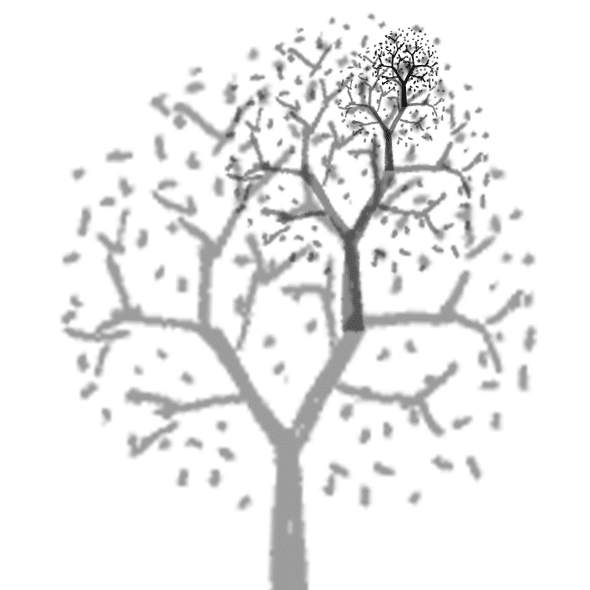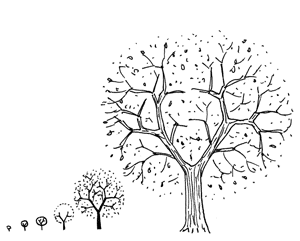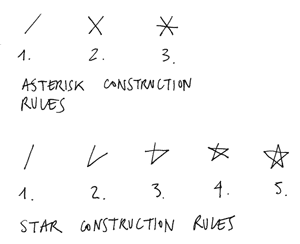
IMAGE ABOVE: Jaime Eizaguirre remixed by Jaime Eizaguirre
Experiment #5: complexity through detail-scale
Drawing the same object-element (a tree) in different sizes with the same tool (same thicknes of line) addapting the level of complexity and detail to the possibilities of each drawing scale.

> Computer analysis and conclusions: Comparing the different drawings by making them all of the same size.
It is quite obvious that hand-drawing is related to size: the size of the paper, the size of the pen, brush, etc. But it’s not that obvious when we work with computers, specially when working with vector graphics, where the workspace and level of precision is almost infinite.

Experiment #6: complexity through construction rules.
Even the simplest of drawings is based on construction rules. Let’s take the asterisk or the star shape as an example:

Another good example is drawing a tree (I based this drawing on the nice construction rules in « Drawing a tree », by Bruno Munari):

This last experiment consists on a series of re-interpretations of the same simple basis: a group of random dots inside a square. 8 drawings are based on this same starting point, and they are all the result of applying some simple rule: connecting the dots with the sides, the centre or the corners of the square, generating circles around them, etc.

> Computer analysis and conclusions:
Creating an animated sequence with these different drawings and overlapping them with the original image, as a way to summarize the whole process.
Following very simple rules can be a practical way to generate complexity in a hand-made drawing.

Any conclusions?
Hand-drawing can be a powerful tool when dealing with complexity. It might not be very precise and it tends to simplify things, but it can be the better connection between our minds and geometry, helping us in our thinking process. On the other hand, computers are able to deal with huge amounts of data and in the most accurate way.
Computers and hand-drawing should be seen as complementary and not antagonical tools, as they are usually presented. As in many other situations, the relation and balance between the analogical and the digital world is the key.
HAND-DRAWING THE COMPLEXITY is a work by JAIME EIZAGUIRRE featured at COMPLEXITYS on FRIDAYS of JUNE
Hand-drawing is a main tool in my work as an architect and illustrator. I usually focus the analysis of this tool from the point of view of simplicity: the power of suggestion of iconic images or hand-drawing as a fast tool to communicate. So, when invited to contribute to this blog I had to ask myself about the relation between hand-drawing and complexity.
I proposed myself a series of short exercises/experiments around this question:
How can we generate complexity through hand-drawing?
Each one of these exercises tries to create complexity through a different concept: variation, combination, randomness…
After drawn and scanned, the exercises are re-worked / transformed in a simple way using a computer, trying to better understand the results of these experiments and the differences between working analogically or digitally. I will also try to extract some kind of conclusions of each of the exercises.
///////////////////
MORE ABOUT JAIME EIZAGUIRRE
